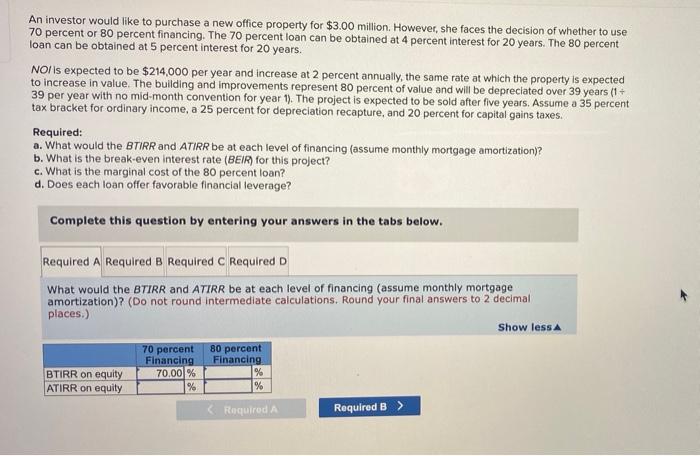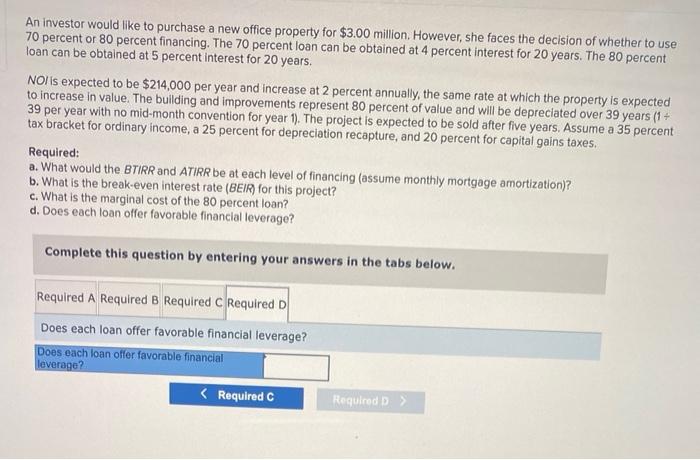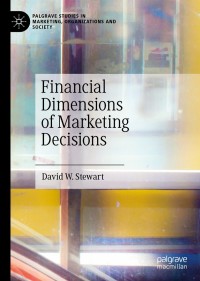Answered step by step
Verified Expert Solution
Question
1 Approved Answer
please help! An investor would like to purchase a new office property for $3.00 million. However, she faces the decision of whether to use 70
please help! 



An investor would like to purchase a new office property for $3.00 million. However, she faces the decision of whether to use 70 percent or 80 percent financing. The 70 percent loan can be obtained at 4 percent interest for 20 years. The 80 percent loan can be obtained at 5 percent interest for 20 years. NOI is expected to be $214,000 per year and increase at 2 percent annually, the same rate at which the property is expected to increase in value. The building and improvements represent 80 percent of value and will be depreciated over 39 years (1+ 39 per year with no mid-month convention for year 1). The project is expected to be sold after five years. Assume a 35 percent tax bracket for ordinary income, a 25 percent for depreciation recapture, and 20 percent for capital gains taxes. Required: a. What would the BTIRR and ATIRR be at each level of financing (assume monthly mortgage amortization)? b. What is the break-even interest rate (BEIR) for this project? c. What is the marginal cost of the 80 percent loan? d. Does each loan offer favorable financial leverage? Complete this question by entering your answers in the tabs below. Required A Required B Required C Required D What would the BTIRR and ATIRR be at each level of financing (assume monthly mortgage amortization)? (Do not round intermediate calculations. Round your final answers to 2 decimal places.) Show less 70 percent 80 percent Financing Financing BTIRR on equity 70.00% % ATIRR on equity % % An investor would like to purchase a new office property for $3.00 million. However, she faces the decision of whether to use 70 percent or 80 percent financing. The 70 percent loan can be obtained at 4 percent interest for 20 years. The 80 percent loan can be obtained at 5 percent interest for 20 years. NOI is expected to be $214,000 per year and increase at 2 percent annually, the same rate at which the property is expected to increase in value. The building and improvements represent 80 percent of value and will be depreciated over 39 years (1+ 39 per year with no mid-month convention for year 1). The project is expected to be sold after five years. Assume a 35 percent tax bracket for ordinary income, a 25 percent for depreciation recapture, and 20 percent for capital gains taxes. Required: a. What would the BTIRR and ATIRR be at each level of financing (assume monthly mortgage amortization)? b. What is the break-even interest rate (BEIR) for this project? c. What is the marginal cost of the 80 percent loan? d. Does each loan offer favorable financial leverage? Complete this question by entering your answers in the tabs below. Required A Required B Required C Required D What is the break-even Interest rate (BEIR) for this project? (Do not round intermediate calculations Round your final answer to 2 decimal places.) Break-even interest rate An investor would like to purchase a new office property for $3.00 million. However, she faces the decision of whether to use 70 percent or 80 percent financing. The 70 percent loan can be obtained at 4 percent interest for 20 years. The 80 percent loan can be obtained at 5 percent interest for 20 years. NOI is expected to be $214,000 per year and increase at 2 percent annually, the same rate at which the property is expected to increase in value. The building and improvements represent 80 percent of value and will be depreciated over 39 years (1 + 39 per year with no mid-month convention for year 1). The project is expected to be sold after five years. Assume a 35 percent tax bracket for ordinary income, a 25 percent for depreciation recapture, and 20 percent for capital gains taxes. Required: a. What would the BTIRR and ATIRR be at each level of financing (assume monthly mortgage amortization)? b. What is the break-even interest rate (BEIR) for this project? c. What is the marginal cost of the 80 percent loan? d. Does each loan offer favorable financial leverage? Complete this question by entering your answers in the tabs below. Required A Required B Required C Required D What is the marginal cost of the 80 percent loan? (Do not round intermediate calculations. Round your final answer to 2 decimal places.) Marginal cost % An investor would like to purchase a new office property for $3.00 million. However, she faces the decision of whether to use 70 percent or 80 percent financing. The 70 percent loan can be obtained at 4 percent interest for 20 years. The 80 percent loan can be obtained at 5 percent interest for 20 years. Nol is expected to be $214,000 per year and increase at 2 percent annually, the same rate at which the property is expected to increase in value. The building and improvements represent 80 percent of value and will be depreciated over 39 years (1 + 39 per year with no mid-month convention for year 1). The project is expected to be sold after five years. Assume a 35 percent tax bracket for ordinary income, a 25 percent for depreciation recapture, and 20 percent for capital gains taxes, Required: a. What would the BTIRR and ATIRR be at each level of financing (assume monthly mortgage amortization)? b. What is the break-even interest rate (BEIR) for this project? c. What is the marginal cost of the 80 percent loan? d. Does each loan offer favorable financial leverage? Complete this question by entering your answers in the tabs below. Required A Required B Required C Required D Does each loan offer favorable financial leverage? Does each loan offer favorable financial leverago? An investor would like to purchase a new office property for $3.00 million. However, she faces the decision of whether to use 70 percent or 80 percent financing. The 70 percent loan can be obtained at 4 percent interest for 20 years. The 80 percent loan can be obtained at 5 percent interest for 20 years. NOI is expected to be $214,000 per year and increase at 2 percent annually, the same rate at which the property is expected to increase in value. The building and improvements represent 80 percent of value and will be depreciated over 39 years (1+ 39 per year with no mid-month convention for year 1). The project is expected to be sold after five years. Assume a 35 percent tax bracket for ordinary income, a 25 percent for depreciation recapture, and 20 percent for capital gains taxes. Required: a. What would the BTIRR and ATIRR be at each level of financing (assume monthly mortgage amortization)? b. What is the break-even interest rate (BEIR) for this project? c. What is the marginal cost of the 80 percent loan? d. Does each loan offer favorable financial leverage? Complete this question by entering your answers in the tabs below. Required A Required B Required C Required D What is the break-even Interest rate (BEIR) for this project? (Do not round intermediate calculations Round your final answer to 2 decimal places.) Break-even interest rate An investor would like to purchase a new office property for $3.00 million. However, she faces the decision of whether to use 70 percent or 80 percent financing. The 70 percent loan can be obtained at 4 percent interest for 20 years. The 80 percent loan can be obtained at 5 percent interest for 20 years. NOI is expected to be $214,000 per year and increase at 2 percent annually, the same rate at which the property is expected to increase in value. The building and improvements represent 80 percent of value and will be depreciated over 39 years (1 + 39 per year with no mid-month convention for year 1). The project is expected to be sold after five years. Assume a 35 percent tax bracket for ordinary income, a 25 percent for depreciation recapture, and 20 percent for capital gains taxes. Required: a. What would the BTIRR and ATIRR be at each level of financing (assume monthly mortgage amortization)? b. What is the break-even interest rate (BEIR) for this project? c. What is the marginal cost of the 80 percent loan? d. Does each loan offer favorable financial leverage? Complete this question by entering your answers in the tabs below. Required A Required B Required C Required D What is the marginal cost of the 80 percent loan? (Do not round intermediate calculations. Round your final answer to 2 decimal places.) Marginal cost % An investor would like to purchase a new office property for $3.00 million. However, she faces the decision of whether to use 70 percent or 80 percent financing. The 70 percent loan can be obtained at 4 percent interest for 20 years. The 80 percent loan can be obtained at 5 percent interest for 20 years. Nol is expected to be $214,000 per year and increase at 2 percent annually, the same rate at which the property is expected to increase in value. The building and improvements represent 80 percent of value and will be depreciated over 39 years (1 + 39 per year with no mid-month convention for year 1). The project is expected to be sold after five years. Assume a 35 percent tax bracket for ordinary income, a 25 percent for depreciation recapture, and 20 percent for capital gains taxes, Required: a. What would the BTIRR and ATIRR be at each level of financing (assume monthly mortgage amortization)? b. What is the break-even interest rate (BEIR) for this project? c. What is the marginal cost of the 80 percent loan? d. Does each loan offer favorable financial leverage? Complete this question by entering your answers in the tabs below. Required A Required B Required C Required D Does each loan offer favorable financial leverage? Does each loan offer favorable financial leverago? 



Step by Step Solution
There are 3 Steps involved in it
Step: 1

Get Instant Access to Expert-Tailored Solutions
See step-by-step solutions with expert insights and AI powered tools for academic success
Step: 2

Step: 3

Ace Your Homework with AI
Get the answers you need in no time with our AI-driven, step-by-step assistance
Get Started


